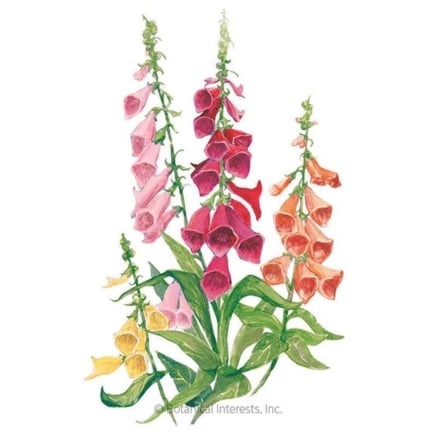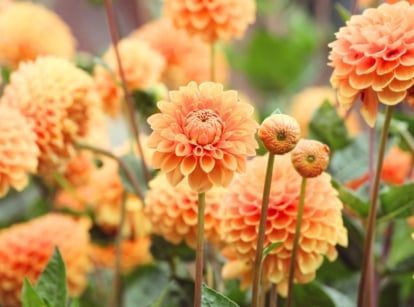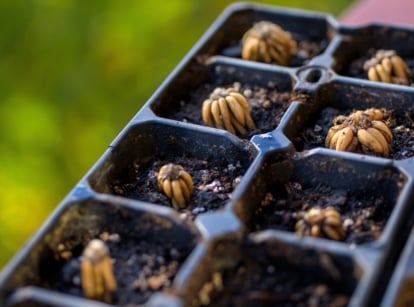9 Flowers You Should Stake Before They Bloom
While many flowering plants grow well without support, others perform best when you stake them. Join flower farmer Briana Yablonski to learn which flowers you should stake before they bloom.

Contents
If you want to enjoy a flower garden filled with long, straight stems and beautiful blooms, add staking to your spring to-do list. While many flowering plants grow well without any support, plants with long stems and heavy blooms benefit from some help. Adding a stake, cage, or trellis helps prevent the plants from toppling over during heavy winds and rains.
You can use t-posts, pieces of bamboo, and fiberglass rods as stakes. The best way to utilize the stakes depends on the plant’s growth habit. Flowers with long, straight stems appreciate a stake for each flower stalk, while bushy plants benefit from being corralled by twine attached to multiple stakes.
Aim to stake your plants before they bloom, no matter which support method you choose. Adding a brace before your plants needs it will help them grow long, straight stems and keep their foliage off the ground.
Ways to Stake Your Plants
When you hear the word staking, you may imagine inserting a single stake and tying a plant to it. This method can work, but it’s not the only one available. Here are a few ways you can support your plants with stakes.
Single Stakes

If you only have one or two plants to stake, you can get away with using a single stake for each plant. This method works best for plants that produce a single, tall, straight stem. Insert the stake close to the base of the plant, then loosely tie the stem to the stake.
Corralling

If you’re growing more than one tall plant in a row, corralling the plants is the best option. This method involves adding stakes on either side of the bed to form a rectangle around your plants. Place the stakes six to ten inches away from the base of the outer plants, adding a stake every five to eight feet.
Once you have the stakes in place, tie a piece of twine to one of the stakes. Carry the twine to the next stake, pull taut, and wrap the twine around the stake. Repeat this process until you have formed a twine box around your flowers.
The box will contain the plants and encourage them to grow straight. I recommend adding your first layer of twine about eight inches above the ground, then adding a new layer of twine every foot as the plants grow.
Netting

At the flower farm I work with, we often rely on horizontal plastic netting to help support our plants. This netting supports fragile stems, keeping them off the ground and encouraging them to remain upright. If you’re growing a whole bed of tall flowers, it’s a great way to support your plants.
Start by gently laying the plastic netting over the top of your bed. Insert two stakes at the top of the bed, ensuring that the netting is pulled taut across the bed. Continue down the bed, pulling the netting tight and adding two stakes every ten feet. The netting should be about a foot above the ground when finished. If you don’t have plastic netting, twine and stakes work too.
One layer of netting is generally sufficient for supporting most flowers. However, you can always add another piece of material to the stakes for an extra layer of support. When the growing season is over, you can roll up the netting and save it for next year.
Tomato Cages

Tomato cages aren’t technically stakes, but they fall in the category of support structures. Since they’re commonly available, they’re a great option for supporting bushy flowers with tall or top-heavy stems.
Insert the tomato cage around your plant when it’s still young. As the plant grows, the cage will contain it and prevent the stems from falling over.
Dahlias

|
|
botanical name Dahlia spp. |
|---|---|
|
|
sun requirements Full sun |
|
|
height 1-6 feet |
|
|
hardiness zones 7-11 |
Healthy dahlias produce thick, branching stems. Although these plants can sometimes remain upright on their own, their hollow stems and heavy flowers often cause them to topple. Adding support helps keep the plants upright and encourages them to produce straight stems perfect for cutting.
Dahlias continue to produce new stems over multiple months, but staking the plants early in the year will provide them with all the support they need. However, you may need to tuck a few stems back into the supportive twine or netting.
How to Stake
A tomato cage is the best method if you’re trying to support a single dahlia plant. Since dahlia plants produce multiple stems over a month, the single-stake method isn’t ideal.
You can support rows of dahlia plants with multiple tomato cages, but I prefer corralling them or using netting. Dahlia plants can get heavy, so pull the string or netting taut to provide adequate support.
Delphinium

|
|
botanical name Delphinium spp. |
|---|---|
|
|
sun requirements Full sun to partial shade |
|
|
height 2-5 feet |
|
|
hardiness zones 3-9 |
Delphinium is one of the most impressive flowers…when it remains upright. The height that makes these flowers so remarkable also makes them prone to falling over. Therefore, it’s best to stake these flowers before they bloom. Staking is especially recommended when growing a taller variety out in the open.
If you don’t want to mess with staking, look for dwarf delphinium varieties that only grow a few feet tall. These flowers may still topple, but they’re more likely to remain upright.
How to Stake
If you’re growing a few delphinium plants, you can use a single stake for each plant. Insert the stake close to the base of the plant, then tie each tall flower stem to the stake.
Corralling works best if you’re growing more than just a handful of plants. As long as the plants are spaced appropriately, the tall stems will work to support one another, and the corral line will help them from toppling over.
Sweet Peas

|
|
botanical name Lathyrus odoratus |
|---|---|
|
|
sun requirements Full sun |
|
|
height 3-10 feet |
|
|
hardiness zones 2-10 |
Sweet peas are synonymous with spring. Since they require cool weather to thrive, spring is the ideal time to grow them. When properly cared for, they’ll provide you with beautiful and fragrant blossoms.
Unlike the other plants on this list, sweet peas are trailing plants, complete with wrapping tendrils. That means they can grab onto whatever type of support you provide. Staking them before they bloom is one option, but providing a trellis at the time of planting is ideal.
How to Stake
If you want to use a stake to support your sweet peas, insert one stake per plant. You may have to help the plants find their way to the stake, but they’ll soon be able to wrap their tendrils around the support on their own.
A trellis is a better way to support a row of sweet peas. You can insert stakes along the base of the plants and use them to secure a vertical piece of cattle panel or plastic netting. Another option is to plant the sweet peas next to an arbor or fence.
Foxglove

|
|
botanical name Digitalis spp. |
|---|---|
|
|
sun requirements Full sun to partial shade |
|
|
height 2-5 feet |
|
|
hardiness zones 4-9 |
Foxgloves make a statement with tall spikes covered with bell-shaped blooms. When the plants are happy, they can grow up to five feet tall and multiple feet wide. Providing the tall flower stalks with support ensures they don’t fall over in early summer storms.
Shorter plants can often grow well without stakes, but taller stems may fall over or develop wavy stems. Adding support to the plants while they’re still small will encourage them to produce straight, healthy stems.
How to Stake
Since foxglove plants often produce only a single flower stalk, inserting a stake close to the plant and gently tying the stem to the support is easy. You can also corral or net the plants if you’re growing multiple in a row.
Peonies

|
|
botanical name Paeonia spp. |
|---|---|
|
|
sun requirements Full sun to partial shade |
|
|
height 2-4 feet |
|
|
hardiness zones 3-9 |
You may have seen herbaceous peonies growing in front of homes without any sort of stake or support. It’s true that these popular plants can grow well on their own. However, if you want to enjoy straight and unbroken stems, staking peonies before they bloom their gorgeous flowers is your best option.
One of the best parts of peonies is their large blooms made up of layers and layers of ruffled petals. However, these large flowers often cause the stems to bend and break, especially after the petals become filled with rain. Providing support keeps the plant upright so you can enjoy long stems and healthy plants.
How to Stake
Since peonies have a bushy growth habit, corralling or caging them is the best way to provide support. You can insert a tomato cage around the plant when they’re still young, or build a box around them using four stakes and twine.
If you have multiple peonies growing in a row, corralling the plants with stakes and twine is your best bet. You don’t have to build a box of twine around each plant; building a twine rectangle around the entire planting works well.
Lisianthus

|
|
botanical name Eustoma grandiflorum |
|---|---|
|
|
sun requirements Full sun to partial shade |
|
|
height 1-3 feet |
|
|
hardiness zones 8-10 |
One of the longest-lasting cut flowers, gardeners and florists love lisianthus for its elegant, rose-like blooms. While we love how each plant produces multiple flowers, this high number of large blooms can cause the stems to topple. Therefore, I highly recommend providing lisianthus with some type of support.
These plants are slow growers early in the season, so it’s easy to think they won’t need support any time soon. However, as soon as the weather warms, their growth rate increases, and they beg for support. Staking the plants when they’re six inches tall will ensure they have the support they need as they mature.
How to Stake
If you’re growing a bed of lisianthus, adding one or two layers of netting above the plants is your best option. The plants will grow through the netting and remain upright. If you notice your plants are growing more than 18 inches tall, it’s a good idea to add a second layer of netting.
You can tie each plant to a single stake. However, this option works best if you only grow a few plants.
Amaranth

|
|
botanical name Amaranthus spp. |
|---|---|
|
|
sun requirements Full sun |
|
|
height 3-5 feet |
|
|
hardiness zones 2-11 |
While you may think of amaranth as an edible grain, some of these species produce beautiful flower heads that add unique texture and color to arrangements. Trailing varieties like ‘Love Lies Bleeding’ send out cascading tassels, and upright cultivars like ‘Hot Biscuits’ produce textured spikes.
Although amaranth often produces thick stems, the large flower heads can still cause the plants to topple over. Staking the plants helps them remain upright.
How to Stake
Adding a single stake against each plant works well if you’re only growing a few plants. Since amaranth stems can grow over an inch in diameter, avoid flimsy wooden stakes and opt for t-posts or other sturdy options. Tie the lower half of the stem to the stake in multiple places.
If you’re growing multiple plants, you can choose to support them by corralling or using netting. Corralling works best if the plants are spaced six inches apart; wider spacing will allow the plants to fall over within the corral.
Larkspur

|
|
botanical name Consolida spp. |
|---|---|
|
|
sun requirements Full sun |
|
|
height 2-4 feet |
|
|
hardiness zones 2-11 |
Larkpur’s tall flower spikes make it a perfect backdrop for cottage gardens and a wonderful addition to cutting gardens. The flowers come in various colors, and the feathery foliage complements the delicate blooms.
Larkspur can sometimes grow well without support. However, tall flower stalks often fall over when the ground becomes moist and heavy winds blow. Staking the plants early in the season will limit root damage and ensure the stems remain upright.
How to Stake
Tying each plant to a single stake works best if you’re only growing one or two plants. Each plant produces a single upright stem, so you don’t have to worry about bushy growth.
Corralling often works well if you have a bed full of larkspur. The string will keep the plants in line, and the tall stems will support each other.
Hollyhocks

|
|
botanical name Alcea spp. |
|---|---|
|
|
sun requirements Full sun to partial shade |
|
|
height 4-8 feet |
|
|
hardiness zones 3-8 |
While sunflowers are often known as impressively tall flowers, hollyhocks are also a good choice if you want towering stems. These flowers can easily grow over our heads and add beauty with their colorful open blooms. They bloom in the summer and are an excellent option for planting along fences or using as a backdrop for smaller plants.
Hollyhocks can sometimes remain upright on their own, especially if you plant them next to buildings or fences. However, plants in open areas are more likely to fall over without support.
How to Stake
The best way to stake hollyhocks is to insert a stake for each plant. Tie the stem to the stake at multiple points for the best support. You can also tie the plants to nearby fences.











